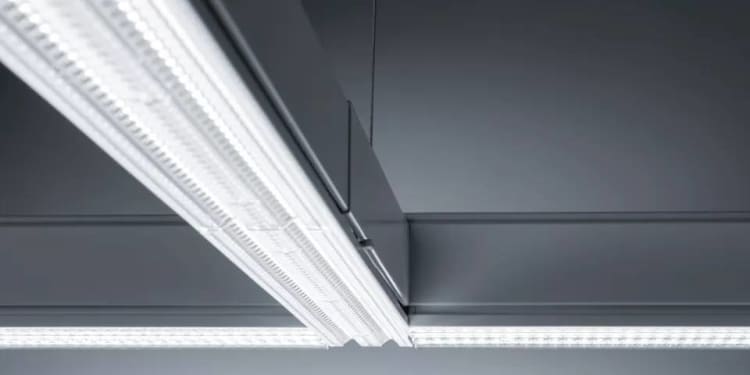
Zumtobel has launched the second generation of its proven Tecton continuous-row luminaire system. The platform has been deployed for more than two decades in supermarkets, high-bay warehouses and production halls, data centers, offices and educational facilities. According to the company from Dornbirn, Austria, more than 39,000 kilometers of Tecton have been installed worldwide. In the new Tecton II series, Zumtobel has refreshed numerous features and the design while retaining established elements, notably the use of Plexiglas molding compounds for the optics.
Explaining the material choice, Maximilian Macha, Global Product Manager Trunking Systems & Protected Luminaires at Zumtobel, said: "The high optical purity of Plexiglas and its surface reproduction accuracy in injection molding are crucial for the homogeneous light distribution and outstanding color rendering that are so important to us in the Tecton II double-split lenses." PMMA is among the most transparent materials, with light transmittance of up to 92 percent. The crystal-clear Plexiglas molding compounds provide high transparency and effective light guiding, supporting demanding optical designs.
Macha added: "In the batten luminaires of the Tecton II system, combining a market-leading LED driver and the Plexiglas lens enables us to achieve a highly efficient system with a luminous efficiency of up to 210 lm/W and a luminous flux of up to 10,000 lumens per meter." The series offers optics that deliver homogeneous distribution and low glare, aligned to varied lighting tasks in retail, logistics and technical environments.

Second generation of the proven continuous-row system: In Tecton II, Zumtobel has updated many features while retaining proven elements. The optics are once again produced from Röhm’s Plexiglas molding compound.
Optical performance and lens precision
The Tecton II portfolio includes an extended range of optics to match application-specific requirements. Wide-beam light distribution supports illumination of open areas, shelves and broad aisles, while narrow-beam options target vertical surfaces such as shelf fronts in logistics or data centers. The double-split lens design produces homogeneous light with precise guidance and reduced glare.
The defined beam characteristics, including “Wide Beam”, “Very Wide Beam”, “Narrow Beam” and “Narrow Shelf Beam”, result from distinct lens microstructures that demand high injection molding accuracy. According to Röhm, the combination of Zumtobel’s toolmaking expertise and the surface reproduction accuracy of Plexiglas molding compounds enables consistently precise optics. Heinz Schubkegel, Senior Business Manager in Röhm’s Molding Compounds business unit, said: "Because our products offer such good flow properties, lighting manufacturers can use them to produce lenses with the finest of structures in consistent quality. Light can be guided precisely." Even large optical components, such as the 50-centimeter lenses in the Tecton II continuous-row system, can be produced with the required dimensional stability.

Tecton II continuous-row system from Zumtobel with a double-split lens made from a crystal-clear Plexiglas molding compound from Röhm.
Service life, robustness and circular design
Zumtobel states that Tecton II luminaires achieve a service life of 100,000 hours with an almost constant light output, characterized as CLO at 95 percent of the original luminous flux, L 95. The lens material contributes to maintaining output over time. Röhm’s PMMA is noted for retaining transparency in lighting applications over long periods. For industrial environments such as production halls, where luminaires face moisture, cleaning agents, temperature fluctuations and dust, Plexiglas offers additional benefits. It is significantly more robust than glass and highly resistant to chemicals, supporting long-term optical performance and overall system durability.
Tecton II was developed in line with Zumtobel’s Circular Design Rules, which reflect cradle-to-cradle principles aimed at conserving resources. The company focuses on recyclable materials and designs systems for straightforward assembly and disassembly, so components can be recovered and returned to the production cycle at end of life. "Recyclable and long-lasting, our Plexiglas material is ideal for Zumtobel’s demanding circular economy concept," said Schubkegel. Zumtobel collects luminaires after use to recycle components. Through various recycling processes, both production waste and Plexiglas components can be returned to PMMA and reused.



